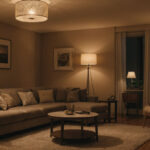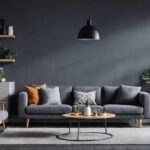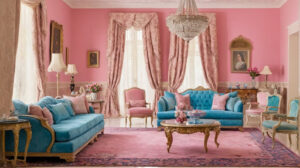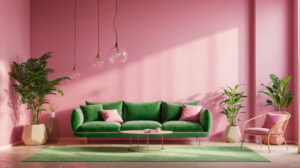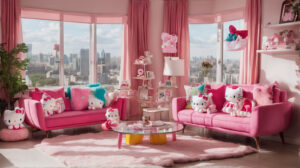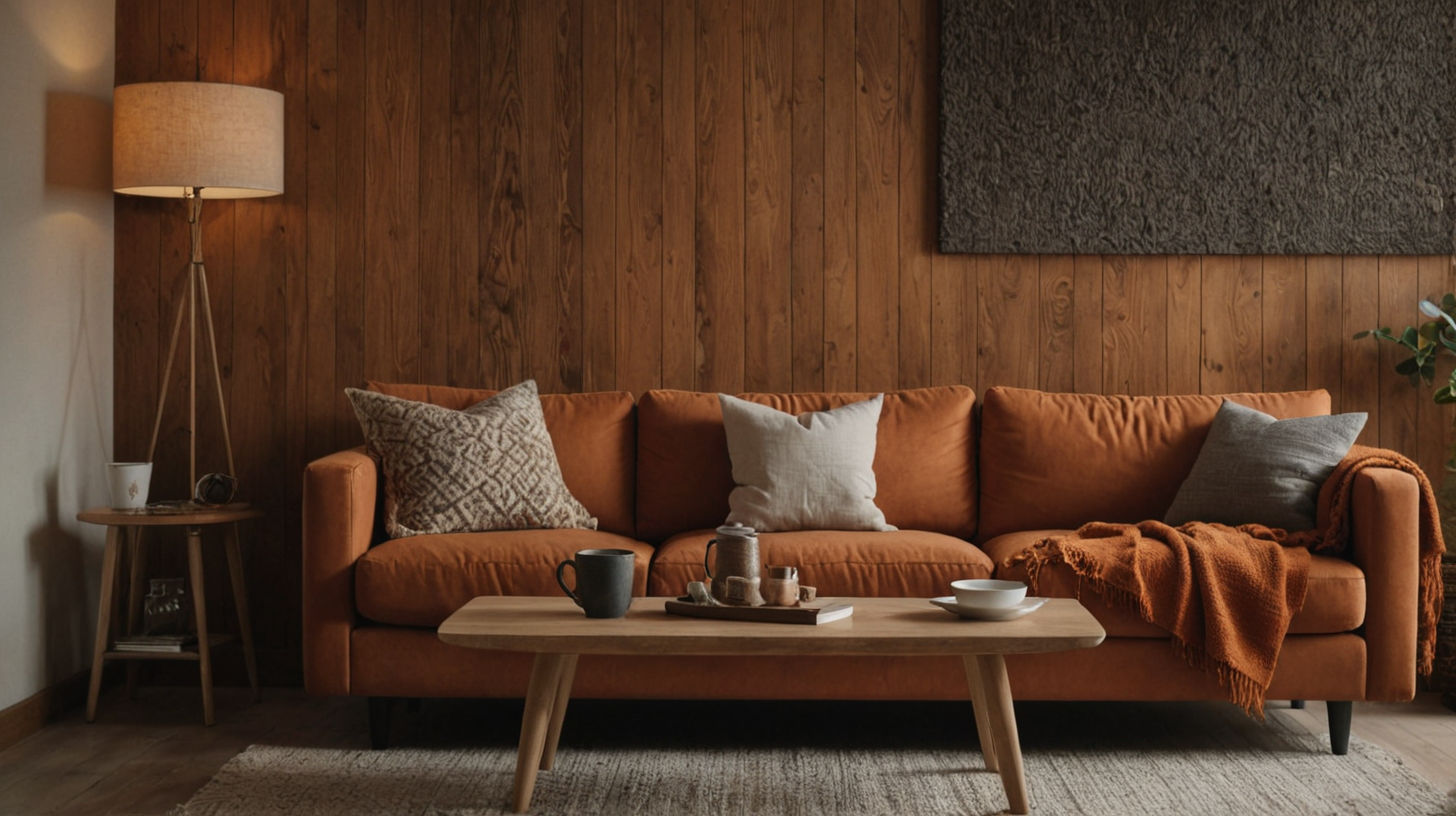
Introduction
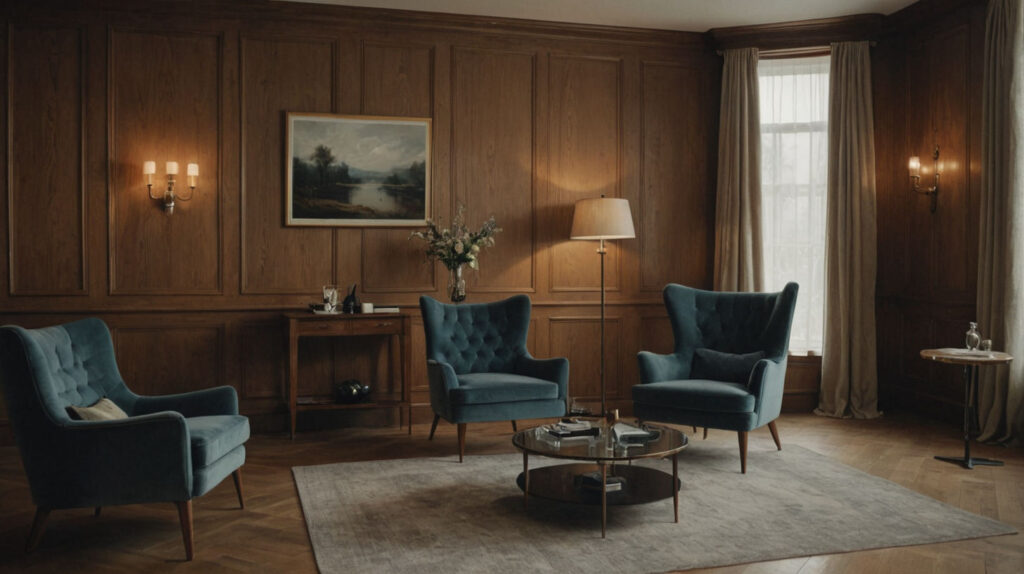
Creating a Rustic Scandinavian Living Room involves blending minimalist Scandinavian design with the warm, earthy elements of rustic decor. This combination results in a cozy, inviting space that exudes simplicity and natural beauty. In this article, we’ll explore how to incorporate wood elements effectively to achieve the perfect Rustic Scandinavian Living Room. From selecting the right types of wood to maintaining your wooden features, we’ll cover everything you need to know to create a harmonious and stylish living space that embodies the best of both worlds.
Key Takeaways
• Rustic Scandinavian Living Rooms combine minimalist design with warm, natural elements.
• Wood is essential for creating warmth, texture, and sustainability in your space.
• Choose from light woods like pine and oak, or dark woods such as walnut and mahogany.
• Incorporate wood in flooring, furniture, walls, and decorative elements.
• Balance wood with other natural materials like textiles, stone, and plants.
• Use neutral color palettes with subtle accent colors to complement wood tones.
• Focus on simplicity, functionality, and personal touches in your decor.
• Proper lighting and maintenance are crucial for showcasing and preserving wood elements.
Table of Contents:
1. Introduction
2. Key Takeaways
3. The Essence of a Rustic Scandinavian Living Room
4. Choosing the Right Wood for Your Living Room
5. Wood Elements to Incorporate
6. Combining Wood with Other Natural Materials
7. Color Schemes and Wood Tones
8. Decorating Tips for a Rustic Scandinavian Living Room
9. Lighting to Complement Wood Elements
10. Maintaining and Caring for Wood Elements
11. Case Studies and Real-Life Examples
12. FAQs
13. Conclusion
The Essence of a Rustic Scandinavian Living Room
A Rustic Scandinavian Living Room is characterized by its unique blend of minimalist Scandinavian design and rustic elements. This style combines the clean lines and functionality of Scandinavian interiors with the warmth and coziness of rustic decor. The result is a space that feels both modern and timeless, sophisticated yet inviting.
Definition and Characteristics:
• Minimalist Scandinavian design: Clean lines, uncluttered spaces, and a focus on functionality.
• Rustic elements: Natural materials, particularly wood, used to add warmth and texture.
• Light-filled spaces: Large windows and minimal window treatments to maximize natural light.
• Neutral color palette: Whites, grays, and beiges form the base, with occasional pops of muted colors.
Why Wood is Essential:
Wood plays a crucial role in creating the perfect Rustic Scandinavian Living Room. It brings warmth and texture to the space, counterbalancing the potentially stark feel of minimalist design. As a natural and sustainable choice, wood aligns with the Scandinavian emphasis on eco-friendly living. From floors to furniture, wood elements help create a connection to nature, fostering a sense of calm and well-being in your living space.
Choosing the Right Wood for Your Living Room
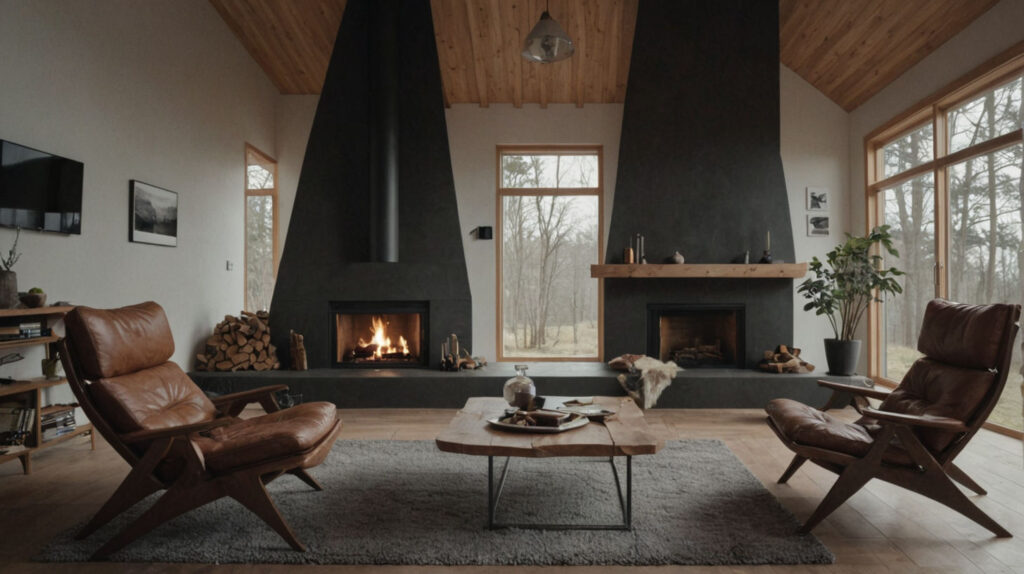
Selecting the appropriate wood for your Rustic Scandinavian Living Room is crucial in achieving the desired aesthetic and functionality. Consider both the type of wood and its sourcing to create a space that’s both beautiful and sustainable.
Types of Wood:
Light Woods:
• Pine: Affordable and widely available, pine offers a light, casual look perfect for rustic spaces.
• Birch: Known for its fine grain and light color, birch is durable and adds a touch of elegance.
• Oak: With its distinctive grain and honey tones, oak is a classic choice for Scandinavian interiors.
Dark Woods:
• Walnut: Rich, chocolate-brown tones make walnut ideal for creating contrast in lighter spaces.
• Mahogany: Known for its reddish-brown hue, mahogany adds warmth and sophistication.
• Teak: Naturally resistant to moisture, teak is perfect for both indoor and outdoor furniture.
When choosing between light and dark woods, consider the overall look you want to achieve. Light woods can make a space feel more open and airy, while dark woods add depth and coziness.
Sourcing Sustainable Wood:
Eco-friendly options:
• Reclaimed wood: Gives new life to old materials and adds character to your space.
• Bamboo: Fast-growing and renewable, bamboo is an excellent alternative to traditional hardwoods.
• FSC-certified wood: Ensures the wood comes from responsibly managed forests.
Certification and suppliers:
Look for suppliers who offer wood certified by recognized organizations such as the Forest Stewardship Council (FSC) or the Programme for the Endorsement of Forest Certification (PEFC). These certifications guarantee that the wood has been sourced sustainably, aligning with the eco-conscious aspect of Scandinavian design.
By carefully selecting the right type of wood and ensuring it comes from sustainable sources, you’ll create a foundation for a beautiful and environmentally responsible Rustic Scandinavian Living Room.
Wood Elements to Incorporate
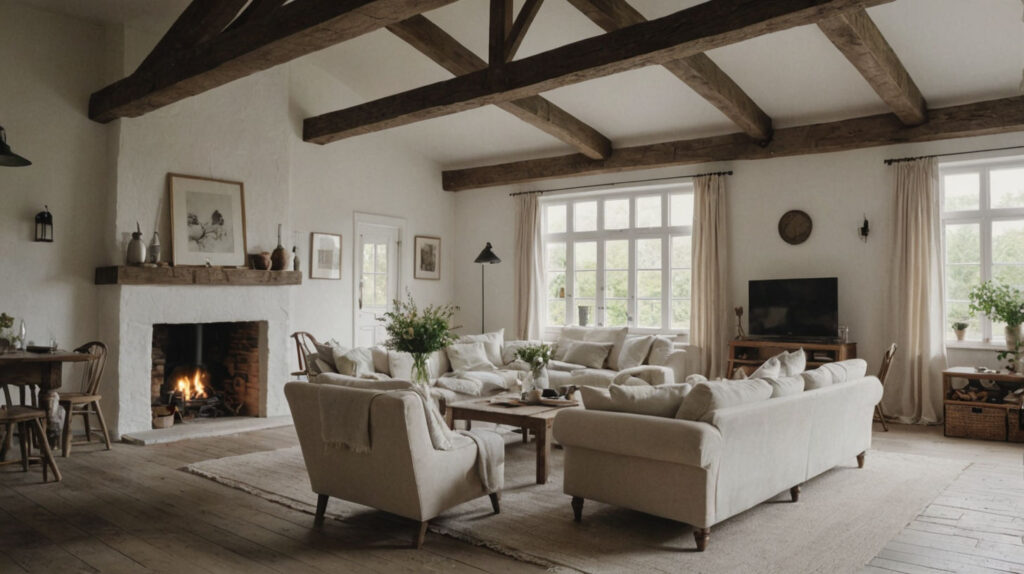
To create an authentic Rustic Scandinavian Living Room, it’s essential to incorporate wood elements throughout the space. Here are key areas where you can introduce wood to achieve the desired look and feel:
Flooring:
Hardwood floors:
• Solid wood flooring: Offers durability and a timeless appeal. Consider wide planks for a more rustic feel.
• Popular choices: Oak, pine, or ash in light to medium tones.
• Finish: Opt for matte or low-gloss finishes to maintain a natural look.
Wood laminate options:
• Budget-friendly alternative to solid wood.
• Look for high-quality laminates that closely mimic natural wood grain.
• Choose water-resistant options for added durability.
Furniture:
Coffee tables, sofas, and chairs:
• Wooden coffee tables: Choose pieces with simple, clean lines and natural finishes.
• Sofa frames: Look for exposed wood frames in light tones.
• Dining chairs: Consider classic Scandinavian designs like the Wishbone chair or simple wooden stools.
Shelving and storage units:
• Open shelving: Install floating wooden shelves for a minimalist look.
• Cabinets: Opt for designs with smooth, handle-free fronts in light wood tones.
• Storage benches: Combine seating with storage using wooden bench designs.
Walls and Ceilings:
Wood paneling:
• Accent walls: Create a focal point with vertical or horizontal wood paneling.
• Shiplap: A popular choice for adding texture and rustic charm.
• Color: Keep it light with whitewashed or natural finishes.
Exposed beams and planks:
• Ceiling beams: Add character and warmth to your space with exposed wooden beams.
• Plank ceilings: Install wood planks on the ceiling for a cozy, cabin-like feel.
• Mix and match: Combine painted and natural wood elements for visual interest.
Additional wood elements:
• Window frames: Replace standard frames with wooden ones for a cohesive look.
• Doors: Consider solid wood doors or those with wooden panels.
• Staircase: If applicable, incorporate wooden treads or a wooden handrail.
When incorporating these wood elements, aim for a balance between rustic charm and Scandinavian simplicity. Mix different wood tones and textures to add depth to your space, but be careful not to overwhelm the room. Remember that in Scandinavian design, less is often more, so choose your wooden elements thoughtfully to create a harmonious and inviting living room that embodies the rustic Scandinavian aesthetic.
Combining Wood with Other Natural Materials
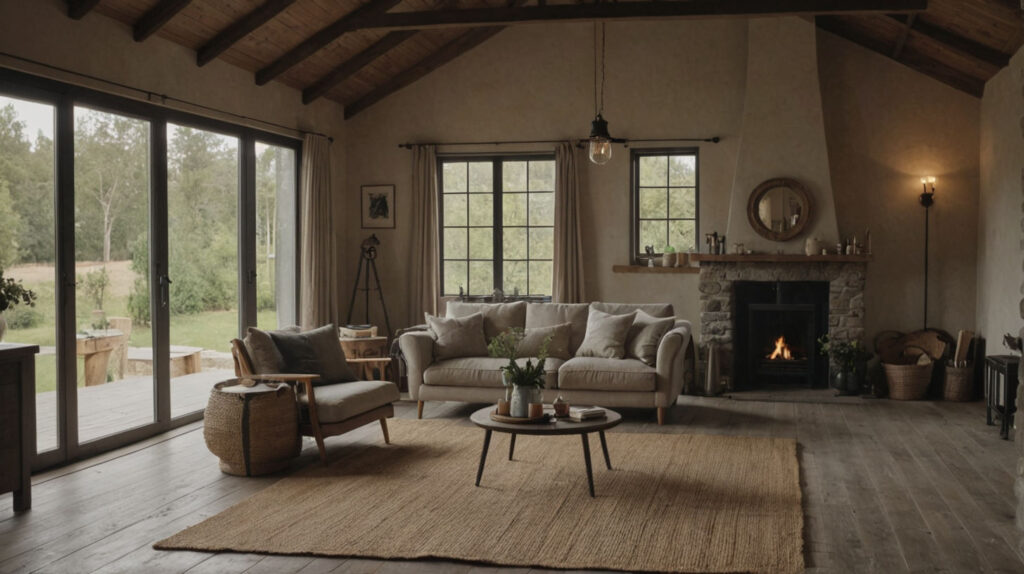
To create a well-rounded Rustic Scandinavian Living Room, it’s important to combine wood elements with other natural materials. This approach adds depth, texture, and visual interest to your space while maintaining a cohesive, nature-inspired look.
Textiles:
• Wool: Add warmth and coziness with wool throws, rugs, or upholstery.
• Linen: Use linen curtains or pillow covers for a light, airy feel.
• Cotton: Incorporate cotton in upholstery, throws, or area rugs for comfort and durability.
Tips for using textiles:
• Layer different textures for added dimension.
• Choose neutral colors with subtle patterns to complement wooden elements.
• Use sheepskins or reindeer hides as throws on chairs or floors for a quintessential Scandinavian touch.
Stone and Metal:
• Stone: Incorporate natural stone in coffee tables, fireplaces, or decorative objects.
• Metal: Use metal accents in lighting fixtures, hardware, or small decorative items.
Complementary elements:
• Concrete: Consider concrete side tables or planters for an industrial-rustic look.
• Leather: Add leather accents in furniture or decorative items for a touch of sophistication.
Tips for combining stone and metal with wood:
• Use these materials sparingly to avoid overwhelming the wood elements.
• Choose finishes that complement your wood tones (e.g., brushed brass with warm woods).
Plants:
Bringing in greenery:
• Large potted plants: Add statement plants like fiddle leaf figs or rubber plants.
• Small succulents: Place on shelves or side tables for low-maintenance greenery.
• Hanging plants: Use macramé plant hangers for a boho-rustic touch.
Tips for incorporating plants:
• Choose pots or planters made of natural materials like terracotta or woven baskets.
• Group plants of varying sizes for visual interest.
• Consider easy-to-care-for plants that thrive in indoor environments.
By thoughtfully combining wood with other natural materials, you’ll create a Rustic Scandinavian Living Room that feels balanced, inviting, and connected to nature. Remember to maintain a sense of simplicity and avoid cluttering the space with too many elements.
Color Schemes and Wood Tones
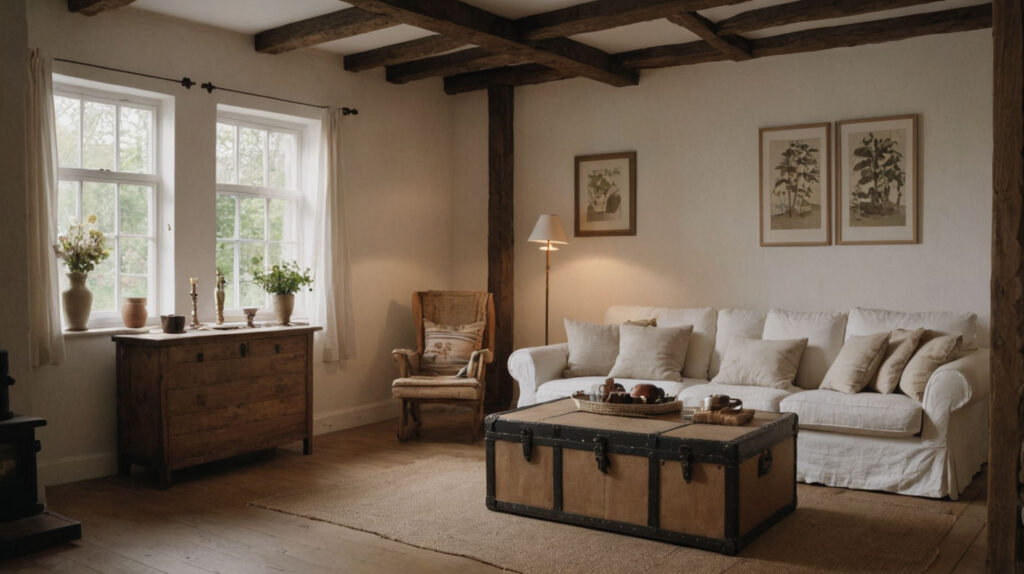
Choosing the right color scheme is crucial in creating a harmonious Rustic Scandinavian Living Room that complements your wood elements. The key is to strike a balance between the warmth of the wood and the coolness of typical Scandinavian palettes.
Neutral Palettes:
• Whites: Use various shades of white to create a bright, airy feel.
• Grays: Incorporate light to medium grays for depth and sophistication.
• Beiges: Add warmth with soft beiges and taupes.
Tips for using neutrals:
• Layer different shades of the same color for visual interest.
• Use matte finishes to maintain a natural, understated look.
• Consider white-washed wood for a seamless blend with neutral walls.
Accent Colors:
• Soft pastels: Incorporate pale blues, greens, or pinks for subtle color.
• Earthy tones: Use muted terracottas, sage greens, or dusty blues for a nature-inspired palette.
Tips for using accent colors:
• Use accents sparingly in textiles, art, or small decor items.
• Choose colors that complement rather than compete with your wood tones.
• Consider seasonal changes in accent colors for easy updates.
Balancing Light and Dark Woods:
• Create contrast: Pair light wood floors with darker wood furniture or vice versa.
• Use multiple wood tones: Incorporate both light and dark woods for depth and visual interest.
• Consider undertones: Ensure the undertones of different wood elements complement each other.
Tips for balancing wood tones:
• Use lighter woods for larger surfaces like floors or walls to keep the space feeling open.
• Add darker wood accents in furniture or decor for grounding elements.
• Unify different wood tones with consistent finishes (e.g., all matte or all glossy).
By carefully selecting your color scheme and balancing your wood tones, you’ll create a cohesive and inviting Rustic Scandinavian Living Room. Remember that the goal is to create a space that feels warm and natural while maintaining the clean, uncluttered aesthetic of Scandinavian design.
Decorating Tips for a Rustic Scandinavian Living Room
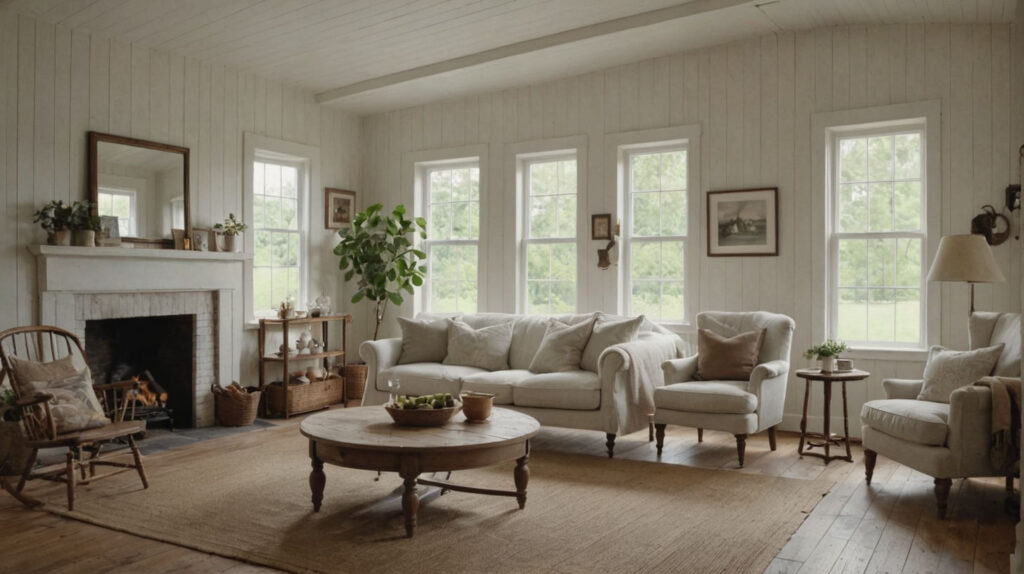
When decorating your Rustic Scandinavian Living Room, focus on creating a space that’s both functional and aesthetically pleasing. Here are some tips to help you achieve the perfect balance:
Simplicity and Functionality:
• Decluttering: Keep surfaces clear and organize items out of sight.
• Smart storage: Use built-in cabinets or multi-functional furniture to maximize space.
• Minimalist approach: Choose a few statement pieces rather than filling the room with decor.
Tips for maintaining simplicity:
• Follow the “less is more” principle when selecting furniture and decor.
• Choose pieces that serve multiple purposes, like a coffee table with storage.
• Regularly assess your space and remove items that don’t serve a purpose or bring joy.
Layering Textures:
• Rugs: Add warmth and define spaces with natural fiber or wool rugs.
• Throws: Drape soft blankets over sofas or chairs for added coziness.
• Cushions: Mix different textures in your throw pillows, such as linen, wool, and knits.
Tips for layering textures:
• Stick to a cohesive color palette when mixing textures.
• Vary the scale of textures, from chunky knits to fine weaves.
• Include smooth textures to balance out rougher, more rustic elements.
Personal Touches:
• Art: Hang nature-inspired prints or black and white photography.
• Books: Display books on open shelving or coffee tables.
• Decorative items: Incorporate handmade or artisanal pieces that reflect your personality.
Tips for adding personal touches:
• Choose items that have meaning or tell a story.
• Group objects in odd numbers for a more pleasing visual arrangement.
• Rotate seasonal decor to keep your space feeling fresh and current.
By following these decorating tips, you’ll create a Rustic Scandinavian Living Room that’s not only beautiful but also functional and personally meaningful. Remember to step back and assess the overall feel of the room, making adjustments as needed to maintain the perfect balance between rustic warmth and Scandinavian simplicity.
Lighting to Complement Wood Elements
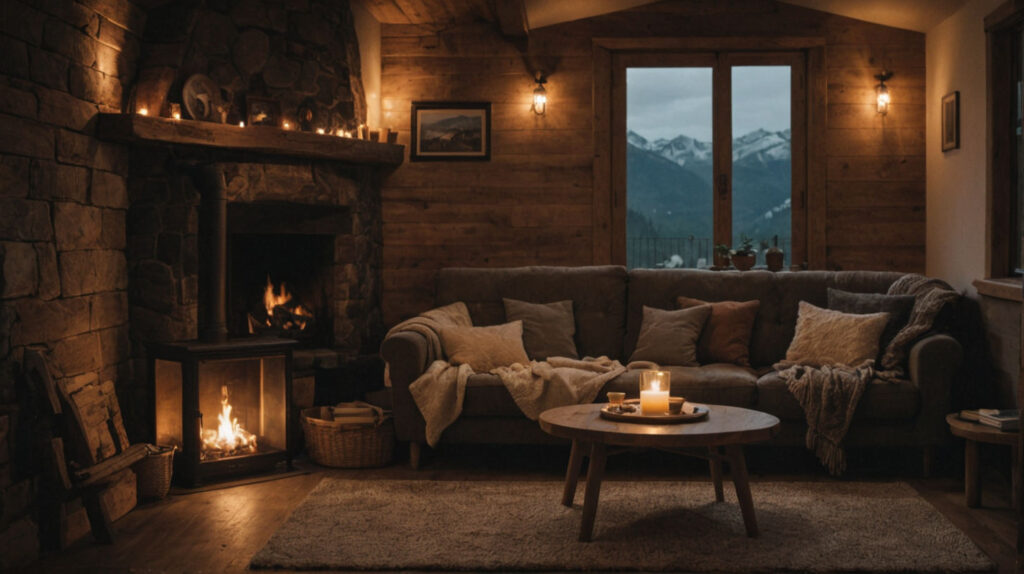
Proper lighting is crucial in a Rustic Scandinavian Living Room, as it enhances the beauty of wood elements and creates the right ambiance. Here’s how to effectively incorporate both natural and artificial lighting:
Natural Light:
Maximizing windows and skylights:
• Keep window treatments minimal to allow maximum light entry.
• Consider installing skylights to bring in more natural light from above.
• Use reflective surfaces like mirrors to bounce light around the room.
Tips for enhancing natural light:
• Position furniture to take advantage of natural light sources.
• Use light-colored curtains or blinds that can be fully opened.
• Keep windows clean to ensure optimal light transmission.
Artificial Lighting:
Warm-toned bulbs:
• Choose bulbs with a color temperature between 2700K-3000K for a warm, cozy glow.
• Use LED bulbs for energy efficiency and longevity.
• Consider smart bulbs that allow you to adjust color temperature and brightness.
Pendant lights and floor lamps:
• Hang pendant lights with wooden or natural material shades over dining areas or coffee tables.
• Use floor lamps with wooden bases to add warmth and provide focused lighting.
• Install wall sconces with adjustable arms for flexible task lighting.
Tips for artificial lighting:
• Layer your lighting with a mix of ambient, task, and accent lights.
• Use dimmer switches to adjust the mood and intensity of light.
• Highlight wood elements with strategically placed accent lighting.
Additional lighting ideas:
• String lights: Add a soft, magical glow with warm white string lights.
• Candles: Use natural beeswax or soy candles for a cozy, flickering light.
• Salt lamps: Incorporate these for a warm, soothing glow and potential health benefits.
By carefully considering both natural and artificial lighting, you’ll create a Rustic Scandinavian Living Room that feels bright and airy during the day and cozy and inviting in the evening. The right lighting will enhance the natural beauty of your wood elements and create the perfect atmosphere for relaxation and gathering.
Maintaining and Caring for Wood Elements
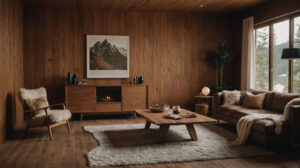
Proper maintenance of wood elements is essential to preserve their beauty and longevity in your Rustic Scandinavian Living Room. Here are some tips for cleaning, preventing damage, and performing minor repairs:
Cleaning and Polishing:
Natural cleaning products:
• Mix equal parts white vinegar and water for a gentle, effective cleaner.
• Use Murphy’s Oil Soap for deeper cleaning of wood surfaces.
• Apply food-grade mineral oil to nourish and protect unfinished wood.
Tips for cleaning wood:
• Dust regularly with a soft, dry cloth to prevent buildup.
• Clean spills immediately to avoid staining or water damage.
• Avoid harsh chemicals that can strip wood of its natural oils.
Preventing Damage:
• Use coasters under drinks to prevent water rings.
• Place felt pads under furniture legs to avoid scratches on wood floors.
• Control humidity levels to prevent wood from warping or cracking.
Tips for damage prevention:
• Rotate rugs and furniture periodically to ensure even wear on wood floors.
• Use window treatments to protect wood from direct sunlight, which can cause fading.
• Avoid placing hot items directly on wood surfaces to prevent heat damage.
Repair and Restoration:
Fixing minor damages:
• Use wood filler to repair small scratches or dents.
• Touch up small areas with a matching wood stain or marker.
• Apply a fresh coat of wood oil or wax to restore luster to dull surfaces.
Tips for repair and restoration:
• Address issues promptly to prevent further damage.
• For significant repairs, consider consulting a professional to maintain the integrity of your wood elements.
• Keep touch-up supplies on hand for quick fixes.
By following these maintenance and care tips, you’ll ensure that the wood elements in your Rustic Scandinavian Living Room remain beautiful and functional for years to come. Regular care not only preserves the aesthetic appeal of your space but also protects your investment in quality wood furnishings and features.
Case Studies and Real-Life Examples
To inspire your Rustic Scandinavian Living Room design, let’s explore three real-life examples that showcase different approaches to this style:
Example 1: Cozy Cabin Living Room
This mountain retreat embraces the rustic aspect of the style:
• Features: Exposed wooden beams, a stone fireplace, and large windows overlooking nature.
• Wood elements: Pine plank flooring, a reclaimed wood coffee table, and a mix of light and dark wood furniture.
• Color scheme: Warm neutrals with pops of deep green and burgundy.
• Key takeaway: Demonstrates how to balance rustic elements with Scandinavian simplicity in a nature-inspired setting.
Example 2: Modern Rustic Apartment
This urban space blends contemporary design with rustic touches:
• Features: High ceilings, large industrial-style windows, and an open floor plan.
• Wood elements: Light oak flooring, a sleek wooden media unit, and minimalist wooden dining furniture.
• Color scheme: Primarily white and gray with black accents and warm wood tones.
• Key takeaway: Shows how to incorporate rustic Scandinavian elements in a modern, city environment.
Example 3: Scandinavian Country House
This family home embodies the essence of hygge:
• Features: A mix of vintage and modern furniture, layered textiles, and plenty of natural light.
• Wood elements: Whitewashed wood paneling, a rustic dining table, and wooden picture frames.
• Color scheme: Soft whites and grays with accents of pale blue and blush pink.
• Key takeaway: Illustrates how to create a lived-in, cozy feel while maintaining Scandinavian design principles.
These examples demonstrate the versatility of the Rustic Scandinavian style, showing how it can be adapted to different settings and personal preferences. Whether you’re drawn to a more traditional rustic look or a modern interpretation, these case studies provide valuable insights into creating a harmonious and inviting living space that combines the best of both rustic and Scandinavian design elements.
FAQs
1. What are the key features of a Rustic Scandinavian Living Room?
A Rustic Scandinavian Living Room combines minimalist Scandinavian design with rustic elements like wood and natural materials, creating a cozy and inviting space. Key features include:
• Clean lines and uncluttered spaces
• Natural wood elements in furniture, flooring, and decor
• A neutral color palette with occasional pops of muted colors
• Emphasis on natural light and simple window treatments
• Mix of textures, including wood, textiles, and other natural materials
• Functional and multi-purpose furniture pieces
• Incorporation of nature-inspired elements and greenery
2. How can I incorporate wood elements effectively in my living room?
To incorporate wood elements effectively in your Rustic Scandinavian Living Room:
• Choose the right type of wood, considering both light and dark options
• Use wood in flooring, furniture, wall paneling, and decorative accents
• Mix different wood tones for depth and visual interest
• Balance wood with other natural materials like stone, metal, and textiles
• Consider sustainable and eco-friendly wood options
• Use wood in both large statement pieces and smaller decorative items
• Maintain and care for wood elements properly to preserve their beauty
3. What color schemes work best with wood elements in a Rustic Scandinavian Living Room?
The best color schemes for a Rustic Scandinavian Living Room with wood elements include:
• Neutral palettes: Whites, grays, and beiges as a base
• Soft pastels: Pale blues, greens, or pinks for subtle accents
• Earthy tones: Muted terracottas, sage greens, or dusty blues to complement wood
• Monochromatic schemes: Various shades of one color for depth
• Contrasting colors: Dark accents against light woods or vice versa
When choosing colors, consider the undertones of your wood elements and aim for a harmonious balance that enhances the natural beauty of the wood while maintaining the clean, airy feel of Scandinavian design.
Conclusion
Creating a Rustic Scandinavian Living Room is about striking the perfect balance between minimalist Scandinavian design and the warmth of rustic elements. By effectively incorporating wood elements, you can achieve a space that is both stylish and inviting. Remember to choose sustainable wood options, mix different wood tones and textures, and complement them with other natural materials.
The key to success lies in maintaining simplicity while adding personal touches that make the space uniquely yours. Whether you’re drawn to the cozy cabin look or a more modern interpretation, the versatility of this style allows for customization to suit your preferences and living situation.
By following the tips and insights provided in this article, from selecting the right wood and color schemes to proper maintenance and lighting, you can create a Rustic Scandinavian Living Room that serves as a peaceful retreat from the outside world. Embrace the principles of both rustic charm and Scandinavian functionality, and you’ll have a timeless, beautiful living space that you’ll enjoy for years to come.
